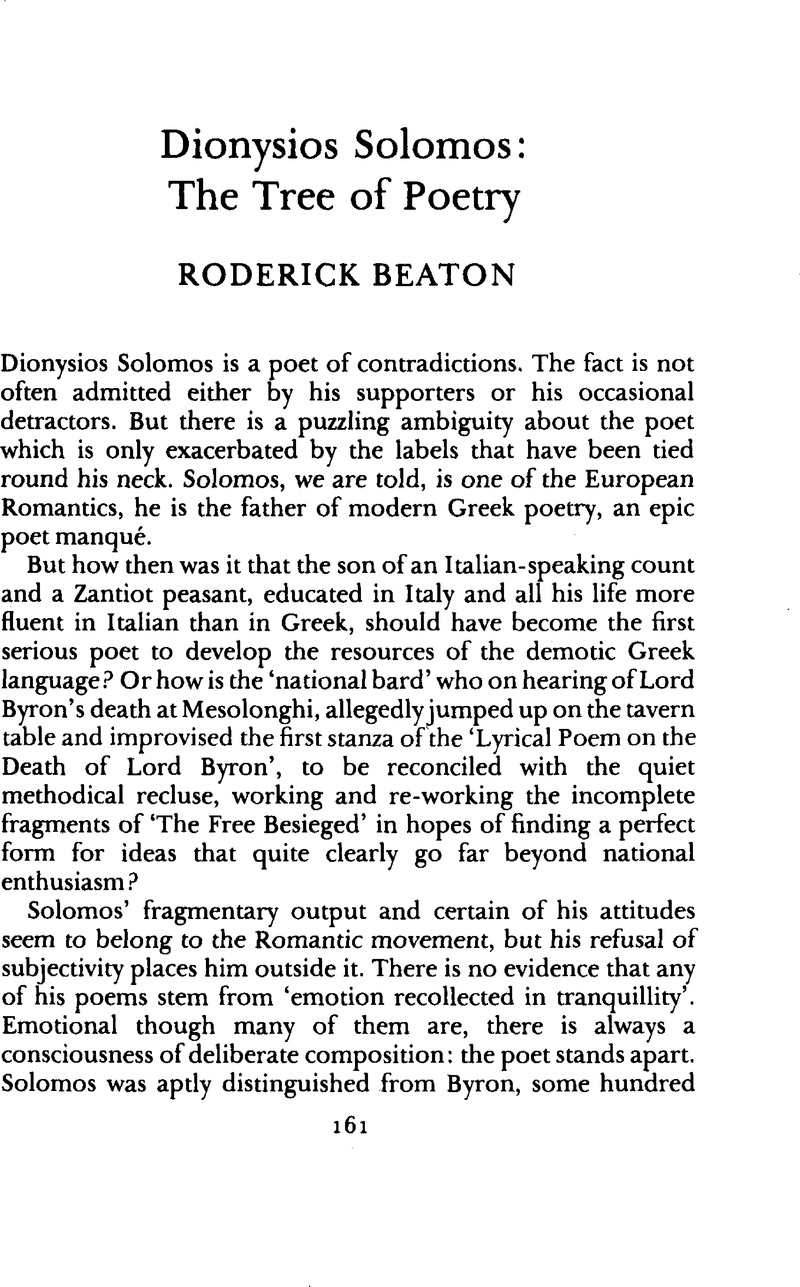Published online by Cambridge University Press: 22 January 2016

1.
Palamas, K., ![]() II (Athens, 1927), p. 55
Google Scholar.
II (Athens, 1927), p. 55
Google Scholar.
2. Solomos has never been given the critical attention, at least in English, that he deserves. Three critical accounts have appeared: Jenkins, R., Dionysios Solomos (Cambridge, 1940)Google Scholar; Sherrard, P., The Marble Threshing Floor: Studies in Modem Greek Poetry (London, 1956)Google Scholar; Raizis, M. B., Dionysios Solomos (Twayne’s World Author Series: New York, 1972)Google Scholar. Of these only that by Sherrard makes a serious attempt to interpret Solomos, while the other two give mainly biographical accounts of the poet’s development, with much attention to his services to the modern Greek language and to explaining the fragmentary nature of his works.
3. All references are to the collected two-volume edition by Politis, L., D. Solomos, Complete Works, I: Poems (Athens, 1948)Google Scholar; II: Prose and Italian Works (Athens, 1955). For’The Cretan’ seel, pp. 197-216; for’The Free Besieged’, I, pp. 207-50; and for the ‘Porfyras’, I, pp. 251-5.
4.
Palamas, K., ![]() (Athens, 1897)Google Scholar; republished in
Palamas, K.,
(Athens, 1897)Google Scholar; republished in
Palamas, K., ![]() ed. Hatziyakoumis, M. (Athens, 1970)Google Scholar.
ed. Hatziyakoumis, M. (Athens, 1970)Google Scholar.
5. It was Polylas, the first editor of Solomos, who conflated the six versions of ‘The Cretan’ that existed in manuscript and established the convention by which the fragments are always numbered 18-22. Polylas comments, on the opening section of the poem, ‘As will be apparent from the beginning of the Fragment, the same is a continuation of a Poem, the seventeen preceding chapters of which the good man had previously composed, or at the least had sketched. Of these, however, no trace was found among the surviving papers’. See
Terzakis, A., ![]() (Corfu, 1859), p. 159
Google Scholar. There is no other evidence that Solomos had any intention of writing seventeen sections to precede the existing fragments. On the unity of ‘The Cretan’ see the excellent monograph by
Maronitis, D. N.,
(Corfu, 1859), p. 159
Google Scholar. There is no other evidence that Solomos had any intention of writing seventeen sections to precede the existing fragments. On the unity of ‘The Cretan’ see the excellent monograph by
Maronitis, D. N., ![]()
![]() (Athens, 1975)Google Scholar.
(Athens, 1975)Google Scholar.
6. Dante, Paradiso, XIV. 61-6: ‘So they appeared ready and eager, both the one chorus (of souls) and the other, to cry “Amen”, and thus clearly showed their longing for their mortal bodies; not perhaps for themselves but for the sake of their mothers or fathers or others who were dear to them before they became sempiternal flames.’
7. See for example St. Clair, W., That Greece might still be Free. The Philhellenes in the War of Independence (Oxford, 1972)Google Scholar, for a brutally unsentimental account of these events.
8. See for example the painting by Delacroix of ‘Greece expiring on the ruins of Mesolonghi’.
9. Ed. Politis, I, p. 216.
10. Ibid., p. 217.
11. Ibid., p. 243.
12. Ibid., p. 230.
13. Ibid., p. 231.
14. Ibid., p. 216.
15. Sherrard, op. cit., p. 24.
16. Ed. Politis, I, p. 235.
17. Ibid., p. 207.
18. Ibid., p. 209.
19. Ibid., p. 209.
20. Ibid., p. 208.
21. Ibid., p. 209.
22. Raizis, op. cit., p. 49.
23. It has often been said that Solomos’ patronage of the demotic language was the result of his mother’s Zantiot origin. In fact Solomos was too objective and deliberate to espouse a cause for emotional reasons alone, and there is evidence that his stand was carefully and precisely thought out on the basis of his experience of the language question in Italy. See
Vitti, M., ![]()
![]() Nea Estia, LXII (1957), 43–9
Google Scholar, and
idem, , ‘Riflessi della questione della lingua italiana sul poeta greco Dionysios Solomos’, Annali dell’ Istituto Universitario Orientale, I (1959), 79–94
Google Scholar.
Nea Estia, LXII (1957), 43–9
Google Scholar, and
idem, , ‘Riflessi della questione della lingua italiana sul poeta greco Dionysios Solomos’, Annali dell’ Istituto Universitario Orientale, I (1959), 79–94
Google Scholar.
24. See
Hatziyakoumis, M., ![]() (Athens, 1968)Google Scholar.
(Athens, 1968)Google Scholar.
25. Ed. Politis, I, pp. 262-3.
26. The story is quoted from the History of the Pseudo-Dorotheos of the late Byzantine period by
Politis, N. G., ![]() II (Athens, 1921), pp. 23–6
Google Scholar. He also quotes a shorter version from the Epic of Achilles, probably of the fourteenth century.
II (Athens, 1921), pp. 23–6
Google Scholar. He also quotes a shorter version from the Epic of Achilles, probably of the fourteenth century.
27.
Petropoulos, D., ![]() II (Athens, 1958), p. 93
Google Scholar. The Greek text (with refrains omitted) is as follows:
II (Athens, 1958), p. 93
Google Scholar. The Greek text (with refrains omitted) is as follows:
 This version of the song was recorded by
Passow, A., Popularia Carmina Graecae Recentioris (Leipzig, 1860), no. DCXXV, p. 468
Google Scholar.
This version of the song was recorded by
Passow, A., Popularia Carmina Graecae Recentioris (Leipzig, 1860), no. DCXXV, p. 468
Google Scholar.